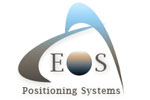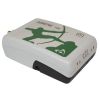Eos Skadi 100 GNSS Receiver
Features
- Provides 40-60 cm-level real-time accuracy using free SBAS corrections only
- Optimized for tough conditions, including dense canopy and urban cityscapes
- Easily shift from a handheld configuration to a range pole mount using included accessories
- Free ground shipping
- Expedited repair and warranty service
- Lifetime technical support
- More
Overview
The Skadi 100 is the entry-level GNSS receiver in the Skadi Series from Eos Positioning Systems. With single-frequency support for all GNSS constellations, the Skadi 100 lets you obtain submeter, mapping-grade accuracy in the field using only freely available satellite-based augmentation systems (SBAS) signals. The Skadi 100 is device agnostic to work with any iOS, Android, or Windows mobile device.
In addition to the accuracy and performance you have come to expect from any Eos GNSS receiver, the Skadi 100 also includes several advanced mapping capabilities available only in the Skadi Series product line. These include an integrated antenna and hot-swap, all-day battery to support any field mounting configuration. With the Skadi Standard Handle that is included in every Skadi 100 purchase, you can seamlessly switch from a handheld field configuration to a range-pole setup and more.
Advanced Mapping Features
The Skadi 100 is the only multi-constellation, device- and app-agnostic GNSS receiver in the Skadi Series product line designed to maximize worldwide submeter accuracy from free SBAS corrections or from an Atlas H50 subscription. With support for four global GNSS constellations, the Skadi 100 is one of the most advanced single-frequency submeter GNSS receivers on the market. Moreover, the Skadi 100 takes advantage of brand-new Skadi Series features including shapeshifting in the field and the Skadi Standard Handle.
Shapeshift in the Field
The Skadi 100 features an integrated antenna and hot-swap, all day battery. These let you work all day in the field with the flexibility of changing your field mounting setups — without wasting time handling any clunky mounting gear nor having to restart your receiver. The Skadi 100’s innovative design and hot-swap battery let you seamlessly move between the included Skadi Standard Handheld configuration, a full or half-sized surveying range pole, and a backpack range pole, for example. Additionally, an external antenna port and cables are available for those who’d wish to mount to a vehicle or use in a hands-free carry-on setup (e.g., backpack, safety vest, chest pack).
Skadi Standard Handle
The Skadi 100 comes with the Skadi Standard Handle, an ergonomic handheld device that allows you to easily combine your mobile smartphone or tablet and GNSS receiver in a flexible, light-weight single hardware setup. Additionally, the Skadi Standard Handle comes out of the box with the correct brackets that free your device’s camera to support any iOS, Android, or Windows smartphone or tablet — no additional purchase necessary.
- Skadi 100 GNSS Receiver with Integrated Antenna
- Pole Mounting Plate for Skadi Series
- Skadi Standard Handle
- Phone Mounting Bracket for Skadi Series Handles
- Tablet Mounting Bracket for Skadi Series Handles
- Skadi Series Li-Ion Battery Pack
- USB-C Power Block
- USB-C Cable
In The News
Three Decades of Research at Acton Lake
A multi-disciplinary team at Miami University, Ohio, has been studying the environmental change at Acton Lake for over three decades. Using three different NexSens buoys over this time, the team has an incredible archive of data that is helping build a picture of Acton’s past, present, and future. Until recently, a NexSens CB-50 buoy was used alongside other environmental monitoring at Acton Lake. In May 2025, the Miami team deployed a new XB-200 buoy , future-proofing their ongoing monitoring using real-time buoy systems. Acton Lake, a small hypereutrophic reservoir in southwest Ohio, covers 2.4km² and has a maximum depth of about 8m. The dam was built in 1956, and the lake has a large agricultural watershed.
Read MoreSource Water Monitoring in Albany, New York: Tracing Water Quality throughout Tributaries
Thousands of US cities pull their drinking water from natural source waters like reservoirs, rivers, and streams, making overall watershed health a key consideration for water providers. In Albany, New York, the Albany Department of Water and Water Supply delivers drinking water to over 100,000 residents as well as monitors and manages the larger drinking water supply watershed. Hannah Doherty, Environmental Specialist at the Albany Department of Water and Water Supply , spends her days working with a small team to monitor the drinking supply and the connected water bodies. Doherty explains, “We’re the first to encounter the water that ends up being the drinking water.
Read MoreWildfire Prevention in the Sierra Nevada Region with the Yuba Watershed Institute
Though recent wildfires have sparked new conversations about wildfire management and response, groups like the Yuba Watershed Institute have been monitoring the forests and water resources of the Sierra Nevada region for decades, managing approximately 5,000 acres of land with the Bureau of Land Management (BLM) and about 7,000 acres in private land partnerships. The goal of the Institute is to work with local communities and land agencies to improve watershed and forestry management through informed practices and public outreach. The goals of the Yuba Watershed Institute are three-fold: Improve the ability of fire suppression agencies like the California Department of Forestry and Fire Protection ( CAL FIRE ) and the US Forest Service.
Read More































